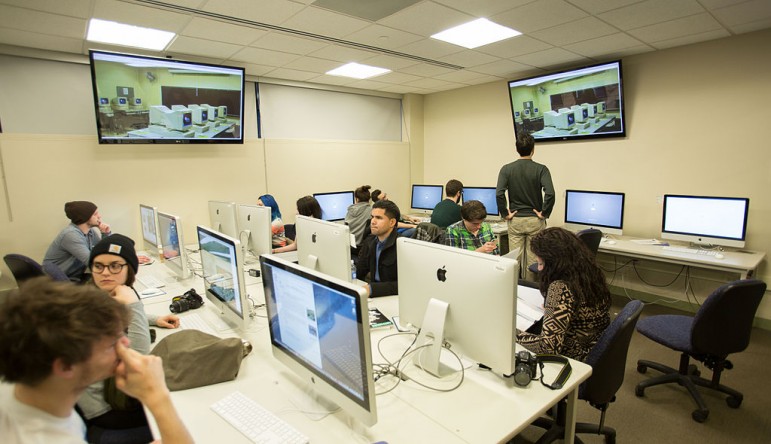By AMELIA HAVANEC
Capital News Service
There’s no doubt: a computer science career can be a lucrative one.

Computer science lab. Image: Wikimedia Commons
Just last year, 248 new technology companies cropped up throughout Michigan, amassing $770 million in private investment, according to the Michigan Economic Development Corp.
Check Michigan’s job boards and you’ll find more than 15,000 openings looking for a set of computing skills.
Not all of those jobs belong to technology companies. In fact, more than half are found across various industries.
But students who enter the workplace right after high school may be deprived of a chance to learn fundamental coding skills.
Though Michigan has K-12 science education standards, they’re outdated, according to Robby Cramer, executive director of the Michigan Science Teachers Association. And the state lacks specific computer science standards that go beyond how to use technology.
“Currently, Michigan standards are below average,” said Cramer, a former teacher in Grand Haven. “Our science standards are very old and they need to be updated based on new science and engineering research.”
The latest tech standards Michigan implemented for its K-12 students were made in 2009 to make sure they could experience new tech platforms and use them in a variety of ways. New science and tech standards were proposed in August, and the state Board of Education will vote on the new standards in October. Absent from those standards is computer coding, which enables the student to structure and manipulate data.
Though not mandatory at Petoskey High School, one elective advanced-placement course is modern web development taught by Howard Bates. It can replace a math credit for seniors.
Eleven students are enrolled in Bates’ class with the expectation of having eight hours of homework a week, he said.
It introduces them to computer programming concepts and allows them to collaborate with other coders on the Internet. The course is a certified Career and Technical Education class that encourages project-based learning.
This year, Bates’ students will create real-world electronic forms for nurses to check patients into emergency rooms and another form for use by ski patrols.
“Local districts determine their curriculum,” said Jennifer Smith, legislative director for the Michigan Association of School Boards.
“While the standard that they want to reach may be the same, how they get there could be very different across the state. That’s not something that we would want to see mandated on how they get from A to B,” Smith said.
The state is working to implement a standardized exit exam at the end of every Career and Technical Education class from an industry standpoint, Bates said.
“The expectation is that when a kid exits the program, that’s considered successful when they’re able to pass that industry standard exam and get a certification,” Bates said.
“They’re not getting certifications right now. I don’t know when it’ll be implemented, but they’ve been working on it for two years now. Part of the problem is that there aren’t that many computer science programs in all of Michigan,” said Bates.
Last time Bates attended a Career and Technical Education seminar in Lansing, there were only three or four other Michigan computer science teachers at his table.
“That’s just anecdotal, but I think it’s tumbleweeds out there,” he said.
Another setback Bates said he notices year after year is the lack of diversity in his computer science classes that are almost 100 percent male. In the 10 years he’s taught at Petoskey High School, only two females completed the course. Also, all his students who took the computer science advanced placement exam for college credit at the end of the last school year are white.
But encouraging diversity in computer-based classes is a nationwide issue. The proportion of women getting bachelor’s degrees in computer science today is only 16 percent compared to 35 to 40 percent in the mid-1980s, despite the field being one of the top-paying college majors, according to the University of Virginia School of Engineering and Applied Science.
Other states are actively promoting computer science.
In the past year, the Maryland State Department of Education allowed computer science courses to satisfy tech credits required from all its public high schools. Doing so may raise diversity in computer science classrooms, since more students can explore the field without having to fit another mandatory class into their schedules.
Washington state, home to tech giants Microsoft and Amazon, created scholarship funds and grants as incentives for teachers to teach and update their own skills in the field. Arkansas passed a law requiring all public and charter high schools to offer computer science classes.
Bates said, “The two things I think I help do for every kid is they decide either in the beginning or later on it’s not for them, and I save them thousands of dollars in college they would have spent to figure it out.
“Or I set them up to know they want to do this,” Bates said. “Almost every one of them continues on to take computer science in college.”